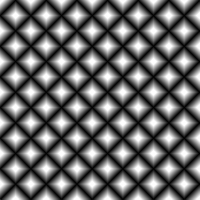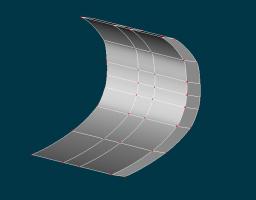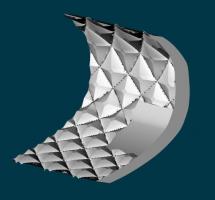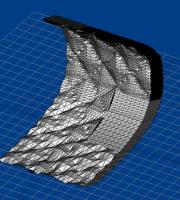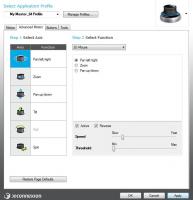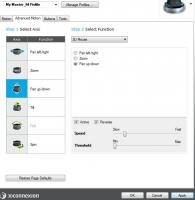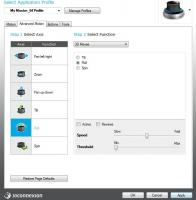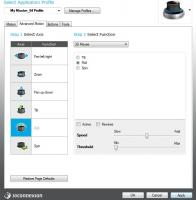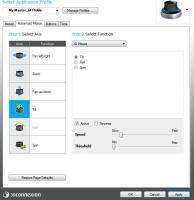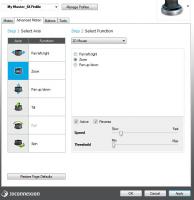-
Posts
1,792 -
Joined
-
Last visited
-
Days Won
16
Content Type
Profiles
Forums
Events
Everything posted by pixelplucker
-
I had posted the source code a while back, not sure what is needed/missing. Probably best developed as a 3rd party plug in. There is info in the header on who wrote it originally. LSCM.txt
-
The uv mapping you wanted is something I requested way way back called LSCM (least squared conformal mapping). It might be a little tough for putting it into AM and might not be worth the effort since there are so many programs on the market already. The bake tool will automatically create uv's without overlaps that can be brought into Painter 3d or 3d Coat. For programs like 3d Coat you need to export a reference object as an obj. You don't need a high tesselation since it is just a proxy to paint on. Painter 3d reads in AM's models directly and is about 1/3 the price. Most that require critical unwrapping will create an action and flatten out the faces, stamp them and so on. This actually has benefits since you can key frame them for further editing if needed. GPU rendering has big limitations since not everyone has a video card that can handle it. Beauty of AM is it runs well even on mediocre laptops.
-
I always check the stl in another program before printing no matter what program I generate the file in. STL Aurora is nice and free and for those that have Unwrap 3d it can preview stl files as well as do minor corrections such as weld close points, correct normals, orientation and scale.
-
I used my knurl bump map for the displacement. Something I had to make for some tool grips a while back. For 3d printing, most printers even the best out there can't hold the tiny tiny details simply because the feature size isn't there. Mainly because they are built at best .001" layer thickness, most at .004". This sounds pretty thin but it isn't. 2048 should be over kill. Most geometry should print fine at 64, especially those that use fdm like Makerbots. What would be nice it the Variable feature that we have in the obj exporter. If that was added to the stl along with a limit to it won't tessellate more than what we check off. Big trick is how that would handle displacement maps if those are determining the details over a series of patches and not by angle.
-
Jason is right when exporting out any geometry with displacement maps 256 is just too course. Global nth subdivisions will generally make larger files than necessary. AM does it's subdivsion based on patches rather than groups or angles which also can pose a problem if a displacement map isn't used on evenly tesselated surface, the map will vary in resolution on export so you need to keep that in mind. Not sure if it is possible to use world based resolution to determine divisions instead of per patch? Maybe divide displacements based on material groups?
-
I would think to integrate a proprietary plug in that needs a specific card or hardware to run would limit the client base. Is there really a need for real time fluids in a program like AM or other animation packages that use a time line and key frames? Updated liquids simulator in AM might be cool if you could have an N'th blob preview to pre-flight the effect then pick up the full res simulation on render time. Something similar for cloth might be nice too.
-
Even though my name wasn't mentioned here in the topic. I did download the ClothTestSimpleSimmed.prj Robcat posted and it runs fine here. Using Win7 Ultimate 64 bit AM version 17g. Just for giggles try turning off your anti virus. Some AV's are so obstructive they do block some applications from functioning properly. I had run into this with Trend Micro where I would get a black screen and no computer response when running some 3d programs and some video games forcing me to hard reset the computer. This was at the time a conflict with a series of Nvidia cards. Just something to check out.
-
I stumbled across this software that is free on sourceforge called Sweet Home 3d. http://www.sweethome3d.com/index.jsp You can quickly layout rooms and even multiple floors with furniture and export them out as an obj from the 3d window. They seem to import ok into the latest AM as props. I'm sure some fiddling and texture work would need to be done but might save some of you the daunting task of making this stuff from scratch in splines for quick scenes. Typical of the opensource stuff watch the installer and make sure your not installing any extra programs that aren't needed such as Real Player or any other garbage. Anyways it's worth checking out. I always found it to be a pain to put in windows, doors and have the proper heights and positions.
-
Didn't Corel acquire Ulead? Same developers? Looks pretty cool, still using Magix for the bit of editing I do.
-
Hmm, when you initially set the profile there are base options to emulate a keyboard, joystick or 3d mouse. Make sure it is set for a 3d mouse and in AM preferences make sure 3d mouse is active. The XML file is the profile I use for my AM settings. You should be able to import it into the Anywhere driver. Click "Manage Profiles" Choose "import" Browse for the xml. I did uninstall the original driver and only use the Anywhere driver here. Something to investigate if it still isn't working.
-
I think you might not have the "active" not checked at the lower portion of the advanced menus tab. I saved the profile out that I use and you should be able to import it in under the profiles menu on top. I also attached screen caps of each of the settings so you can see how mine is set. Big thing is to tweak the speeds and dead zones because they vary for each user. Master_64.xml
-
Yes you can set preferences for each application, even applications that don't support a 3d mouse. http://www.3dconnexion.com/supported-software/anywhere.html I had a couple of other programs that would read the axis opposite than the 3d mouse showed. It isn't really an AM thing but the base driver for 3d Connexion was always quirky. I really love the Anywhere driver. It solved many issues they had with supported and unsupported software by allowing the device to use inputs from standard devices ie: keyboard, joystick, mouse as well as 3d mouse. I use my 3d mouse to rotate, pan and zoom pages in Manga as I draw
-
Have you tried the anywhere driver 3d connnexion is offfering. It alllows you to set default program preferences as well as emulate keyboards joysticks and mouse inputs. That is what I have been using and works really well for me.
-
If you want to do a test, make a lathe object. Scale the ends to close it and test. See if the cp's just have to be close enough to read as closed when printing or if there are any errors. Curious if the software will read in multiple cp's as one if the resolution is finer than can be printed. If that is the case then creating objects in sections will be really helpful.
-
What about open surfaces such as lathe objects, don't you need to close those entities first?
-
You can use Hexagon. There is an offset surface function built in as well as the ability to view and orient normals, weld points, decimate and close openings. Daz still offers it for free and it is far easier than Blender. I believe that support structures will depend on the type of printer and usally the output service will make those. In the case of polyjet or solidscape printers, the support structure is printed at the same time as the main material (positive and negative models printed at the same time) so there is no additional modeling required. Support structures are needed for FDM such as Makerbots or SLA systems where the resin is too fluid to suspend the objects.
-
They in trouble? Patent violations? Uh Oh. 3d systems seems like a pretty scummy company. I had looked into some of their products. I have some concerns on their overall business ethics especially when they contact the customers of the service bureau's that use their equipment to try to make sales. Not sure what patent they might have violated but sla is pretty old technology, uv curing resins is also old technology. IMO it is probably some bully tactics in order to take the company over.
-
Ahh interesting, I'm waiting to see the Formlabs sla machine, supposed to be out next month. If the resolution is good for what I need I may spring for one. Tired of using service bureaus that are run by incompetent idiots. The Solidscape machines are still pretty pricey even for the older used ones.
-
Maker Bots software automatically hollows out objects? I did see where you can set a % of fill on objects. That seems pretty handy. Most of the stuff I output goes to polyjet or sla. Unlike fdm systems that draw on tool paths with material, the polyjets go line by line, row by row. You need to manually create the hollows within the model.
-
Amazing model, are there people in the planes or are my eyes playing tricks on me from all the details? Great stuff
-
You can use multiple shapes and butt them to each other and they will print as one piece. not sure how intersecting objects would work. Objects that are very close will print as one piece even if they are not touching in the z axis depending on the printers resolution (.001 for wax, polyject and sla) Meshes do need to be closed. Make sure the normals are facing outward or your file will have errors. You can use a free program like Hexagon to weld close faces as well as check the stl file prior to export. As far as wall thickness you have to set that yourself. It is a good idea to build structures hollow when possible to reduce the cost of the prints since most will charge by cm³ I thought there is a way to offset a surface in AM, was it a plugin? In AM you can build the object in separate patches as you need, keep cp's between patches lined up so when you export them you can average weld them into one unified shape.
-
You can select those cp's and scale them to o,o,o which will put them all in exactly the same spot. Type in the 0's to make sure.
-
I have several programs I can text your obj file with to make sure it isn't corrupt. There is a chance the obj may have too many polygons and AM could be just taking a long time to import it. I have had that with stl files that have mill+ polys. Just very slow going and not recommended.
-
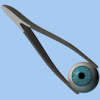
Should I renew my A:M subscription?
pixelplucker replied to Rodney's topic in Work In Progress / Sweatbox
10. Your keyboard will get really dusty 9. Staring at a blank desktop just isn't fun (anymore) 8. Clicking your mouse is irresistible 7. Twirling in your office chair makes you dizzy 6. Your just a few thousand dollars short of a Max subscription 5. You spend more on beer and get less done 4. Swapping over to Blender makes your eyes glaze over 3. Too hard to resist making Jacobs ladders with splines (accidentally) 2. Too much fun undoing Jacobs ladders done with splines 1. You will miss my stupid humor on the forums -
PLY is a polygon model file developed by Stanford University. Triangulation in a ply would be the same as 3ds or stl files but there are slight differences in the ply that are out there that cause some compatibility problems. PLY files can handle larger polygon counts than a 3ds. For the most part obj files are the most supported when hopping between programs because of their texture handling, ability to support triangles and quads. This is the format you may find the most useful. Keep in mind the MTL file generated from an obj is only necessary when there are textures and or materials assigned. Stl files are primarily used in the 3d printing industry and support only triangles and do not support textures. Most 3d scanners will produce a a point cloud or stl file. You can use the stl to trace over in AM or take your creation from AM and print it out on a Makerbot or other 3d printer.









